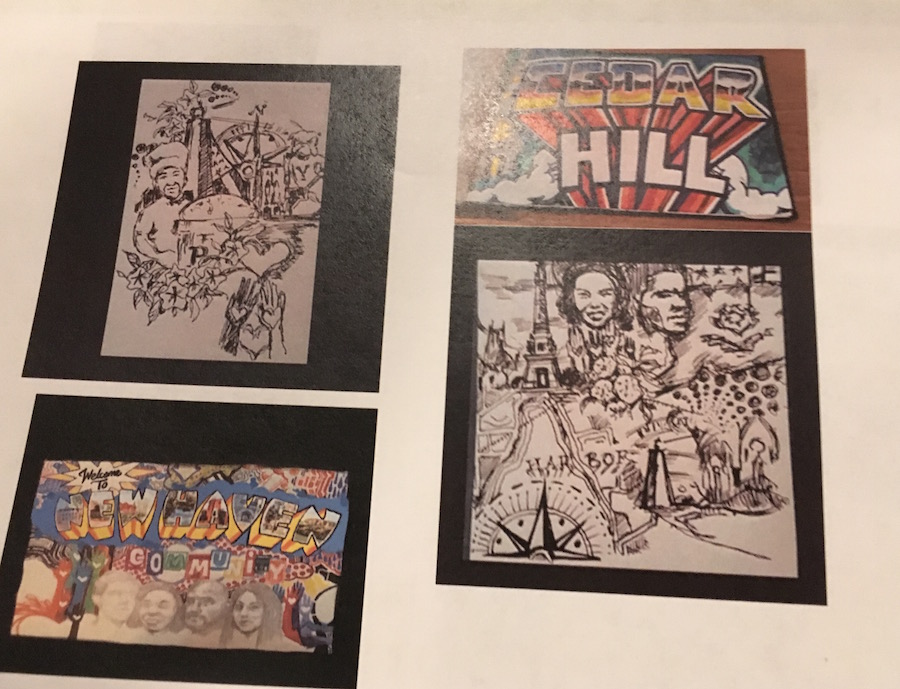
Camille Ansley | Cedar Hill | Cedar Hill Association | Commun | East Rock | Economic Development | Linda Lindroth | Arts & Culture | New Haven
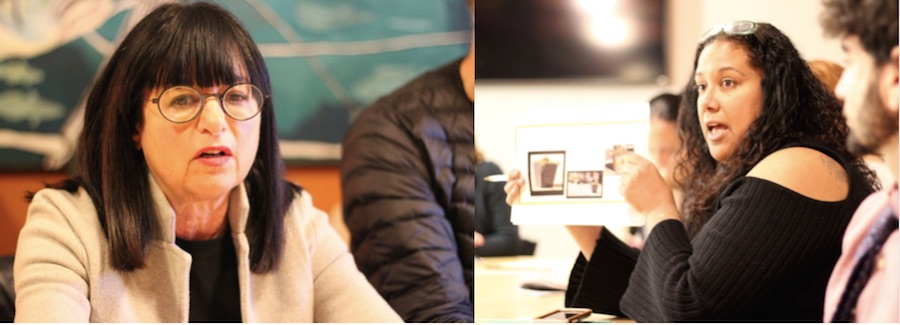 Artist Linda Lindroth is advocating for bringing in new public art to calm traffic at Livingston and Cold Spring Street, where there is a dangerous four-way stop. Camille Ansley wants to see grassroots neighborhood beautification in Cedar Hill. The Neighborhood Public Improvement Funds (NPIP) budget may only be able to cover one. Lucy Gellman Photos.
Artist Linda Lindroth is advocating for bringing in new public art to calm traffic at Livingston and Cold Spring Street, where there is a dangerous four-way stop. Camille Ansley wants to see grassroots neighborhood beautification in Cedar Hill. The Neighborhood Public Improvement Funds (NPIP) budget may only be able to cover one. Lucy Gellman Photos.
A two-walled mural welcoming visitors to New Haven. New, heavy planters to spruce up the edge of East Rock Park and all the way down to State Street. A little free library for Cedar Hill kids who have nowhere else to get books.
Or a zigzagging, colorful, loud pattern that will help drivers slow down, and come to a full stop at a dangerous East Rock intersection.
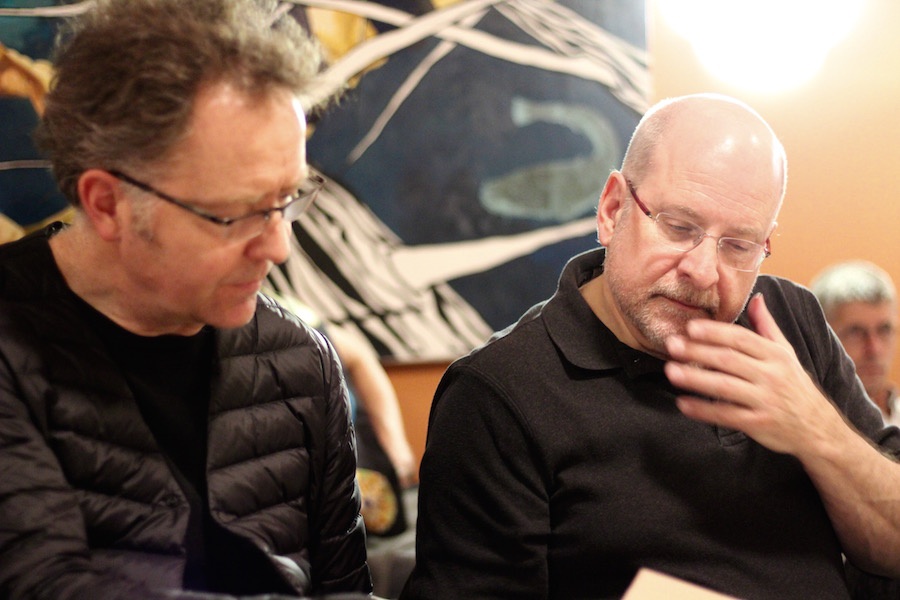 Craig Newick and ERCMT Chair David Budries on Monday night.
Craig Newick and ERCMT Chair David Budries on Monday night.
Those competing visions for two New Haven neighborhoods landed at the East Rock Community Management Team (ERCMT) meeting Monday night, as early contenders for $10,000 in Neighborhood Public Improvement Project (NPIP) funds. Close to 30 attended the meeting, held in its usual spot at mActivity Fitness Center on Nicoll Street.
The funds, given to each of the city’s 12 community management teams, are distributed each year through New Haven’s anti-blight Livable City Initiative (LCI). From the $10,000, money can be allocated to multiple projects, but often goes to a single neighborhood initiative. The ERCMT is taking proposals through its next meeting, scheduled for April 23 at mActivity.
On Monday, two visions emerged: further beautification efforts for Cedar Hill, an eight-block neighborhood between State Street and East Rock Park, cut off from the rest of East Rock by Interstate 91. Or bright, trompe-l’œil patterned crossings at Livingston and Cold Spring Streets, designed as traffic-calming measures for a treacherous four-way stop. A third proposal for electric car charging stations appeared on the agenda, but there was no one in attendance to speak about it.
A Cedar Hill Welcome To New Haven
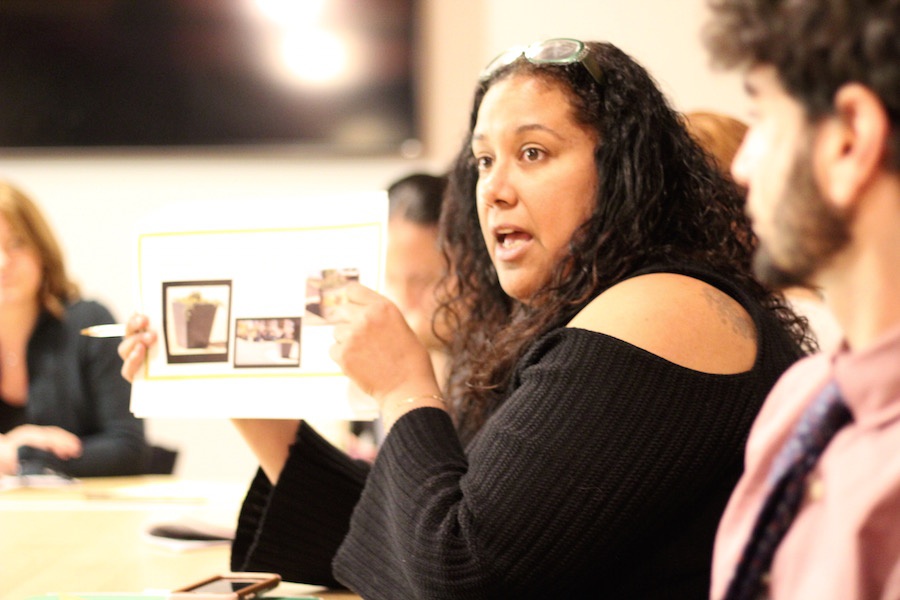
Last year, ERCMT members and Chair David Budries voted for all $10,000 to go to neighborhood beautification efforts in Cedar Hill. They included new planters, a do-it-yourself little free library, a “Welcome To Cedar Hill” mural inspired by the Humphrey Street “Under 91” project, and an intern to help with social media efforts. In particular, the projects were intended to offset illegal dumping, a large amount of which takes place in that section of the city.
But those plans were largely foiled as they were put into place—planters with their plants, hand-painted garbage cans, and a little free library painted by neighborhood kids were all stolen or hit by cars within months of their installation. The mural planned for the 1-91 underpass has been delayed by financial woes and bad weather, although priming is set to begin next month, and painting the month after. So Cedar Hill is asking for that money again—with new plans in place to stop theft.
“We still believe that we need to do something for the beautification of Cedar Hill,” said Ansley at Monday night’s meeting.


She noted that the proposal is not asking for funds to replace items that have been lost. She and neighborhood advocate Kennya Adams-Martin are seeking donations for those, with plans to anchor them with concrete, metal, and even chains. She is still looking for a newspaper box to replace a little free library that was stolen, but said she has made some progress since issuing a public request in December of last year.
Instead, the 2018 NPIP proposal is asking for funds for new cement planters along State Street, from Albert Street to Warren Place, “to spruce up the entrance” to New Haven. Ansley said she is interested in getting neighborhood kids involved in painting and tiling the planters, and speaking to the Urban Resources Initiative (URI) and the Pardee Rose Gardens to make the planters more affordable. Last year, each cement planter ran the group $500 a piece.
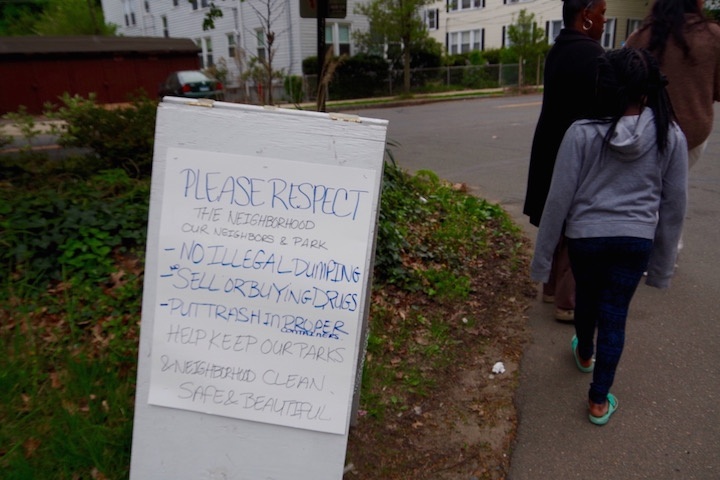 A walkthrough of Cedar Hill last year.
A walkthrough of Cedar Hill last year.
She added that she plans to reach out to Fair Haven’s Community Management Team to see if there’s interest in collaboration, since the neighborhoods touch each other at the Ferry Street bridge. She said she’d also like to put up a large sign welcoming motorists and pedestrians to Cedar Hill, but does not yet have a cost breakdown for that addition.
“Everybody knows me—I like to go big,” Ansley said, giggling. “If I ever could get a Wooster Street kind of big, wrought-iron sign that says ‘Welcome to New Haven,’ I would. But we know we can’t do that for $10,000.”
As the proposal stands, any leftover funds will go toward a second wall of the I-91 mural project, priming for which is set to begin in April. In the months between last year’s NPIP cycle and this one, she said that the group has brought on the New Haven artist Tank and made progress with plans for the mural, but realized that it will cost more than $10,000 to complete by this summer. Artist renderings show multiple designs for the wall: “Cedar Hill” in big, rainbow-colored block letters; images of East Rock’s Soldiers and Sailors monument surrounded by prominent New Haveners, and a design based on the city’s old harbor.
Now, the group is looking for fundraising opportunities to get to its total for the mural, which Ansley did not have but said is over $10,000. The Arts Council of Greater New Haven has signed on as a fiduciary, meaning that it will help with fundraising efforts but is not subsidizing the project.
“We’re Gonna Bring The Art Guys In”
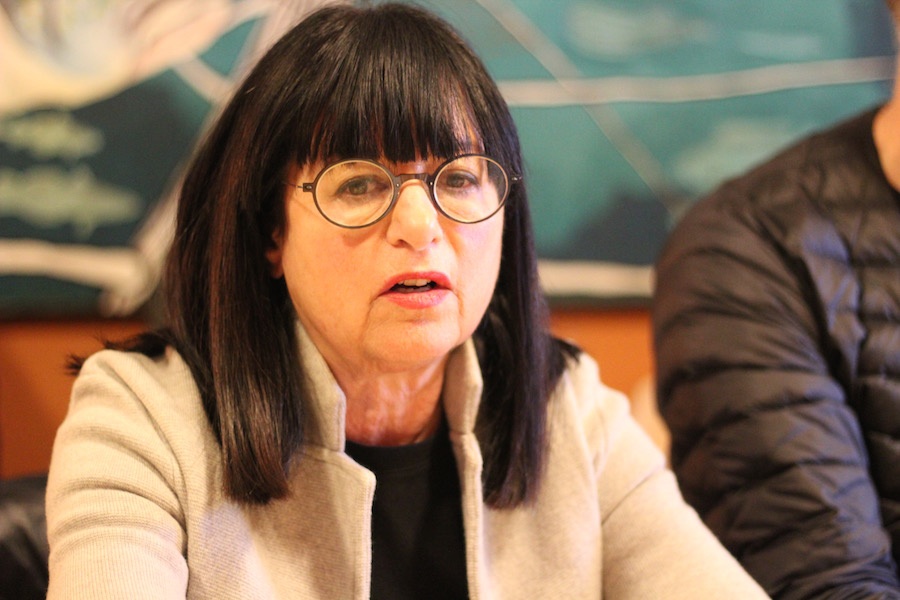 Linda Lindroth: “The city has made suggestions, promises. Engineers have come to the corner with papers. And nothing really happens. So we’re gonna bring the art guys in.”
Linda Lindroth: “The city has made suggestions, promises. Engineers have come to the corner with papers. And nothing really happens. So we’re gonna bring the art guys in.”
On the other side of East Rock Park, artist Linda Lindroth and her husband, architect Craig Newick, have noticed a need for a different kind of beautification effort: One that can calm traffic with innovative public art, when signage fails to do the trick. Living on the corner of Livingston and Cold Spring Streets for 30 years, Lindroth said she has seen hundreds of accidents with pedestrians, cyclists, and cars.
The culprit: A four-way stop for which drivers don’t fully stop, or yield to pedestrians.
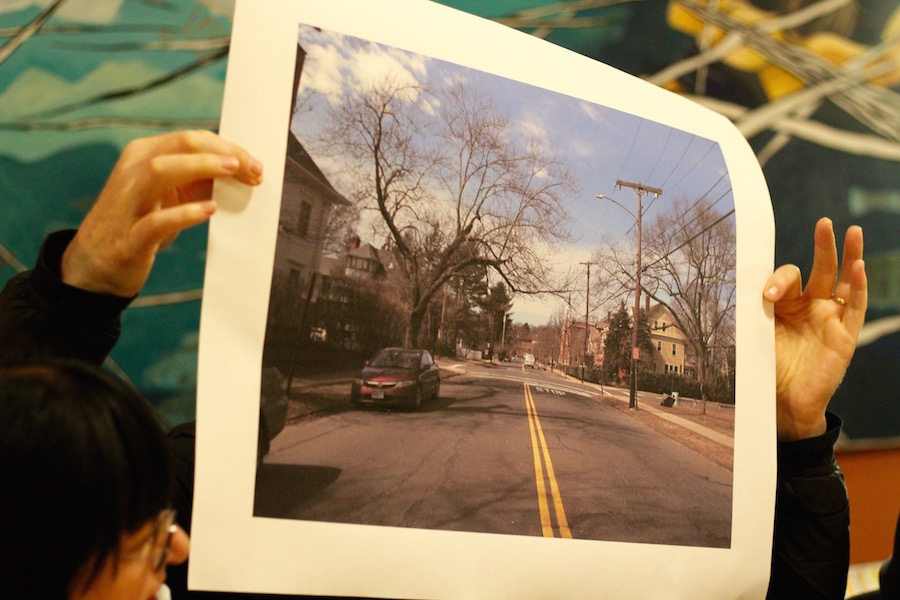 Craig Newick dsplays the intersection.
Craig Newick dsplays the intersection.
It’s a particularly busy intersection because of what’s around it—Leila Day Care on Cold Spring Street, Worthington Hooker School on Whitney Avenue, and Wilbur Cross on Mitchell Drive.
Both Lindroth and District Manager Lt. Renée Dominguez said it’s also the route cops take when they drive from Newhallville to Cedar Hill, sometimes tearing through at well over the speed limit with their sirens blaring. And Lindroth, after having her car door knocked off and watching school kids almost get hit for decades, said she’s had enough.
“We have been to the city several times over the last 10 years,” she said, Newick pulling up a picture of the intersection taken at street level. “The city has made suggestions, promises. Engineers have come to the corner with papers. And nothing really happens. So we’re gonna bring the art guys in.”
Specifically, “art guys” that can practice traffic calming with public art. In the past months, Lindroth has started doing research on international public art projects intended not only to beautify spaces, but slow down speeding drivers. She said she has become especially enamored of a trompe-l’oeil design from Iceland, where a crosswalk in the city of Ísafjörður appears to be levitating because of the perspective in which it is drawn.
 Instagram.
Instagram.
She has also found designs in Madrid, Los Angeles, and Baltimore, the latter of which recently installed a black-and-white “Hopscotch Crosswalk” downtown and has painted several city crosswalks with bright colors.
Drawing on the Broad Museum of Art in Los Angeles, she also cited an example that was completed as a community project, with Los Angeleans helping to fill in the designs.
That resonated with Ansley. “Why aren’t we getting the kids involved,” she asked. “Kids are gonna go home and tell their parents—there’s a huge community action for people to slow down. And if it’s us that are speeding, our kids are our worst conscience. The campaign should be that we have all these schools. Let’s go talk to the schools about how we get the community involved in it.”
But the first pattern was also met with some skepticism. “What about the opioid problem?” asked Ansley, as the table erupted in laughter. “I’m sorry, but what about people who are high?”
In the back of the room, someone muttered that drivers shouldn’t be operating their cars if they are high. Before Lindroth could answer fully, Dominguez stepped in.
“My concern from a safety standpoint would be that this would cause accidents,” Dominguez said. “So I would just love to see data.”
Meanwhile, meeting secretary Deb Rossi said that she didn’t know if new art would make a difference.
“I would be curious to know if the data supported [this],” she said. “Because yes—obviously, you pull up to a stop sign, it would catch your eye the first time. But does it catch it the 50th time? If we’re the ones doing the speeding … I would be curious to see what the data says.”
“Well, sometimes you have to take action before there is data,” argued landlord Susan Frew from the other side of the table.
From the back of the room, Cold Spring Street resident Liza Comita chimed in. In the past two years, Comita’s car has been hit four times (“totaled once, and this December we had to replace the entire rear axel”) by cars speeding through the intersection. Then six months ago, her 6-year-old daughter was almost hit while walking home from school with a friend and her friend’s father. Comita said she’s met with the city’s Department of Engineering, which suggested painting in a line to show parking spaces on both sides of the street.
“It tricks people into thinking that the street is narrower and slows them down,” she said. “So having that coupled with something like this would be really effective and beautiful at the same time.”
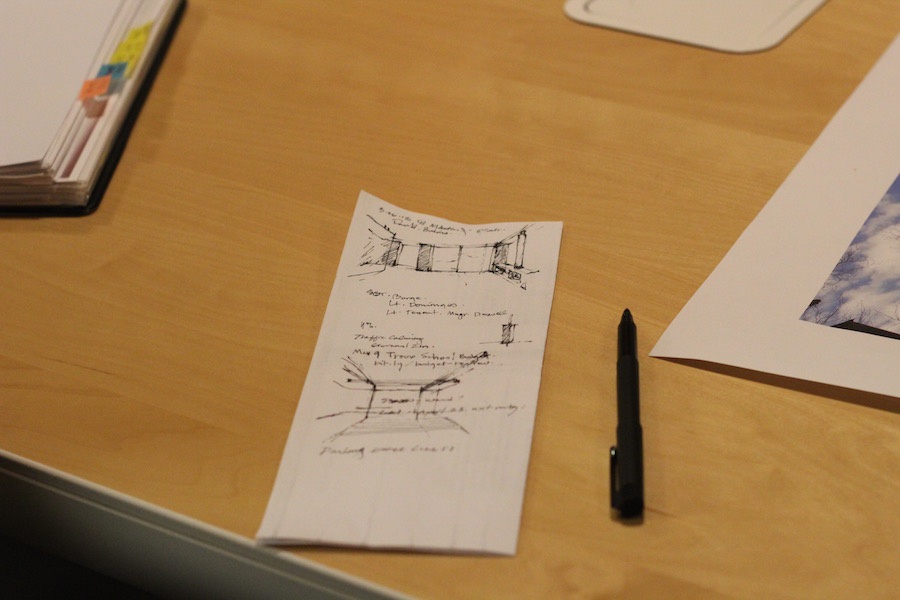
If the proposal goes forward, Lindroth will have to get permission from the city’s Department of Traffic, Transportation and Parking, but does not think that will be a problem.
Lindroth said that local public art nonprofit Site Projects has expressed interest in the project, and proposed both subsidizing the work and bringing in 94-year-old Venezuelan artist Carlos Cruz-Diez to do it, as likely his last commission ever.
Reached by email Tuesday afternoon, Clarke said that she is unsure that Cruz-Diez would be able to make the trip "because he is quite ancient at this point" but that she remains interested in the project.
"We are very interested in this idea and will assist with this project by lending our experience and our expertise," she wrote. "This seems like a very savvy team. We would like to see work like this in many intersections around the city. This is where public art—visual art in public place—can make a wonderful difference in people's daily lives."
If it remains a community-based project without Cruz-Diez, Lindroth said she expects that the total will come in under $10,000.
It’s a project that has a fleeting precedent in New Haven. Nine years ago, Ward 7 Alder Abby Roth recalled, a group painted a bright elm leaf at the corner of York and Cedar Streets to slow traffic around Yale’s hospital complexes and medical school. But the group used the wrong kind of paint, and the leaf disappeared within days.
As the meeting wound down, Ansley made her way over to Lindroth, to introduce herself and discuss the project. She proposed doing a trial run in Cedar Hill, by the neighborhood’s splash pad and playground on View Street. She added that she was excited by the proposal generally.
“I love this idea,” she said. “Something that benefits one side of the park benefits all of us.”

